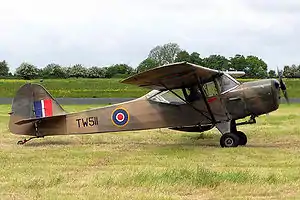| No. 656 Squadron RAF | |
|---|---|
| Active | 31 Dec 1942 – 15 Jan 1947 29 Jun 1948 – 1 Sep 1957 |
| Country | |
| Branch | |
| Role | Air observation post squadron |
| Motto(s) | Latin: Volans et videns (Translation: "Flying and seeing")[1] |
| Insignia | |
| Squadron Badge heraldry | In front of two gun barrels in saltire, a Chinthe head[1] |
| Aircraft flown | |
| Reconnaissance | de Havilland Tiger Moth Auster Auster AOP.6 Auster AOP.9 |
No. 656 Squadron RAF was an air observation post unit of the Royal Air Force in India and Burma during the Second World War and afterwards in British Malaya. Numbers 651 to 663 Squadron of the RAF were air observation post units working closely with British Army units in artillery spotting and liaison. Their duties and squadron numbers were transferred to the Army with the formation of the Army Air Corps on 1 September 1957[2][3] With this it became 656 Light Aircraft Squadron Army Air Corps.
History
Formation and World War II
No. 656 Squadron was formed at RAF Westley on 31 December 1942.[4] It embarked for India in August 1943 and went into action during the Burma campaign with the Fourteenth Army. Several officers were decorated, among them Captain Edward Maslen-Jones who was awarded the Distinguished Flying Cross and the Military Cross.[5]
The squadron was to take part in the Allied invasion of Malaya, but the Japanese surrendered before this took place and the squadron disbanded on 15 January 1947.
Reformation and Operation Firedog

The squadron reformed from No. 1914 Flight RAF on 29 June 1948 at Sembawang in Malaya and served in British Malaya to support Army and Police against Communist guerillas before it went over to Army control in September 1957. 656 Squadron performed a total of 143,000 operations in Malaya during Operation Firedog.
No. 1914 Air Observation Post Flight was formed within 656 Squadron.[6]
Aircraft operated

| From | To | Aircraft | Variant |
|---|---|---|---|
| January 1943 | August 1943 | de Havilland Tiger Moth | Mk.II |
| January 1943 | March 1943 | Auster | Mk.I |
| February 1943 | August 1943 | Auster | Mk.III |
| November 1943 | June 1945 | Auster | Mk.III |
| October 1944 | June 1945 | Auster | Mk.IV |
| February 1945 | January 1947 | Auster | Mk.V |
| June 1948 | May 1951 | Auster | AOP.5 |
| July 1950 | April 1956 | Auster | AOP.6 |
| September 1955 | September 1957 | Auster | AOP.9 |
References
Notes
- 1 2 Halley 1988, pp. 445–446.
- ↑ Halley 1988, p. 444.
- ↑ Jefford 2001, pp. 102–105.
- ↑ Maslen-Jones 1997, pp. 4 and 172.
- ↑ Michael Ashcroft (13 September 2012). Heroes of the Skies. Headline. ISBN 978-0-7553-6391-9.
- ↑ Lake 1999, p. 100.
- ↑ Halley 1988, p. 447.
- ↑ Jefford 2001, pp. 103–104.
Bibliography
- Flintham, Vic; Thomas, Andrew (2003). Combat Codes: A Full Explanation and Listing of British, Commonwealth and Allied Air Force Unit Codes since 1938. Shrewsbury, Shropshire, UK: Airlife Publishing Ltd. ISBN 1-84037-281-8.
- Halley, James J. (1988). The Squadrons of the Royal Air Force & Commonwealth, 1918–1988. Tonbridge, Kent, UK: Air-Britain (Historians) Ltd. ISBN 0-85130-164-9.
- Jefford, C.G. (2001). RAF Squadrons, a Comprehensive record of the Movement and Equipment of all RAF Squadrons and their Antecedents since 1912 (2nd ed.). Shrewsbury, Shropshire, UK: Airlife Publishing Ltd. ISBN 1-85310-053-6.
- Lake, Alan (1999). Flying units of the RAF. Shrewsbury: Airlife. ISBN 1-84037-086-6.
- Maslen-Jones, E.W., MC, DFC. (1997). Fire by Order: Recollections of Service with 656 Air Observation Post Squadron in Burma. Barnsley, UK: Leo Cooper/Pen And Sword Books. ISBN 0-85052-557-8.
{{cite book}}: CS1 maint: multiple names: authors list (link) - Warner, Guy (2013). From Auster to Apache: The history of 656 Squadron RAF/AAC 1942–2012. Barnsley, UK: Pen And Sword Books. ISBN 978-1-78159-098-0.